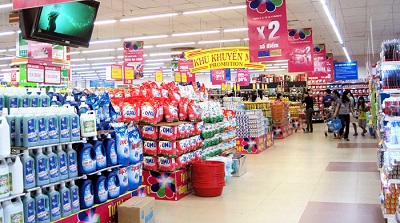With the third largest population in Southeast Asia, nearly 70% of the population is of working age (16-60 years old), Vietnam is a large market for the FMCG industry. The process of international economic integration is deepening, the per capita income is increasingly improving, which is the driving force for the consumer goods industry in general and the fast-moving consumer goods industry, in particular, to develop strongly in the near future. next time.
Vietnamese consumers have many choices of Vietnamese products
FMCG (or consumer packaged goods) is a group of low-priced products that are consumed, turned around, and expired quickly within a short period of time (usually less than 1 year). In the light industry sector, FMCG includes major product groups such as beverages (including beer), food, dairy, household, and personal care products, and tobacco…
In the period 2010 – 2014, Vietnam’s economy had a high and stable growth rate (about 5-7 %/year), leading to stable growth of the consumer goods sector in general and consumer goods. fast in particular. In, the growth rate of real consumer spending in retail is 3%, consumer goods (non-food and beverage) 6%, and other food, and beverage 3%.
In the period 2014-2015, the beverage product group continued to have a good growth rate with 38% of the total sales of the FMCG industry and achieved the highest growth rate of 6.7%. . The development of beverage products mainly comes from beer, energy drinks, and soft drinks. Milk and dairy products increased by 12% in urban areas and 20% in rural areas. In contrast to the beverage product group, the consumption market for the remaining product groups is still facing many difficulties, especially for household care products such as washing powder, packaged food, etc.
The total net revenue of sectors related to consumer goods in Vietnam is expected to increase to 140 billion USD in 2016. This is a great opportunity for fast-moving consumer goods enterprises (SMEs) to step up. production, expand markets and seek growth opportunities.
In terms of market, the growth rate of the FMCG industry in 6 main cities of Vietnam (Hanoi, Ho Chi Minh City, Hai Phong, Can Tho, Nha Trang, and Da Nang) seems to be gradually slowing down. When saturated, the rural market emerges as a new source of growth.
While urban growth was only about 1.6%, the rural market grew by 2.7%, mainly due to growth in consumption volume. The leading product groups with the fastest growth in the rural market are energy drinks, dishwashing liquids, bottled/canned milk, bottled water, and soft drinks…
Vietnam’s rural population accounts for 68% of its 90 million population and currently only 54% of FMCG sales go to rural areas. Income growth in rural areas has also reached about 44% over the past three years. This shows that the rural market still has many potential opportunities. Expansion to the rural market in Vietnam is appropriate and it is important to have an appropriate investment focus plan in place in rural areas.
Sustainable development of the fast-moving consumer goods industry
Although they have achieved relatively positive growth over the past time, in general, enterprises producing fast-moving consumer products still have some limitations such as weak financial capacity, and many products that depend on the source of goods and services. imported material…
With the goal of providing solutions for the sustainable development of the industry in general and the fast-moving consumer goods industry in particular in Vietnam, in the “Vietnam Industrial Development Strategy to 2025, with a Vision to 2035,” The Prime Minister approved in Decision No. 879/QD-TTg dated June 9, 2014, specifying: Effectively mobilize all resources from domestic and external economic sectors for development and restructuring. modern industrial structure; focus on training skilled, disciplined, and creative industrial human resources; to give priority to technology development and transfer to industries and fields with competitive advantages and modern and advanced technologies in a number of fields of agriculture, forestry, and fishery processing, electronics, telecommunications, new and renewable energy, mechanical engineering and pharmaceutical chemistry; adjust the distribution of industrial space reasonably in order to promote the strength of linkage between industries, regions, and localities to deeply participate in the global value chain.
To realize the contents of the Vietnam Industrial Development Strategy in the coming years and to overcome existing limitations, create conditions for the FMCG industry to develop sustainably in the domestic market, and to gradually dominate foreign markets, the State should continue to issue appropriate development promotion policies. In, the main focus is on supporting businesses to promote, register product trademarks, protect industrial property, trade promotion, training, and provide information about the market…
In addition, businesses need to have a strategy to promote investment and product development in rural areas. It is very important to build appropriate distribution channels, and at the same time to introduce, promote and sell products conveniently, in accordance with the consumption culture of different regions, to support the consumption of goods. chemical. In particular, businesses need to promote the development of new products because the consumer goods market is constantly changing, and the improvement and creation of new products not only stimulate consumer demand but also help the market grow.
Vietnam has one of the youngest population structures in the world (56% of the population is under 30 years old) and total consumer spending in Vietnam is expected to double and reach approximately $173 billion by 2020. That will lead to an average growth rate of the FMCG market in Vietnam of about 20% per year, surpassing major markets such as India, and China…

